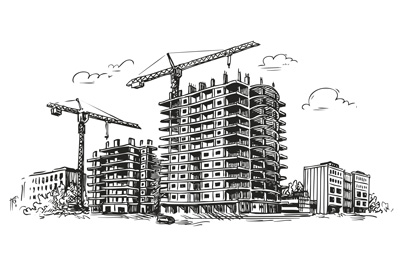Zeitgeist - News Highlights
The Solution to Housing Affordability is More Supply
According to a recent National Low Income Housing Coalition (NLIHC) report, extremely low-income households – those who earn 30% of the median income – account for nearly a quarter, or 11 million, of the nation’s renters. About 74% of them are severely cost-burdened, spending over half of their income on rent. The root cause of this (and many housing-related challenges, generally) is a lack of supply.
 For decades, housing advocates have been pounding the table for more multifamily construction to help boost supply, the most important step in alleviating the affordability crisis. In 2021-2022, a combination of low interest rates and top-of-the-market enthusiasm spurred a major increase in multifamily construction starts. According to CBRE, over 900,000 multifamily units are under construction and approximately 440,000 of those units are scheduled to be delivered in 2024, the highest levels since the 1980s. The new supply has temporarily cooled rent growth, increased rental concessions and helped overall affordability.
For decades, housing advocates have been pounding the table for more multifamily construction to help boost supply, the most important step in alleviating the affordability crisis. In 2021-2022, a combination of low interest rates and top-of-the-market enthusiasm spurred a major increase in multifamily construction starts. According to CBRE, over 900,000 multifamily units are under construction and approximately 440,000 of those units are scheduled to be delivered in 2024, the highest levels since the 1980s. The new supply has temporarily cooled rent growth, increased rental concessions and helped overall affordability.
Ultimately, the new supply being delivered is nominal relative to the total shortfall and will not resolve the long-term issue. And due to the high cost of construction, most of the new product being delivered is Class-A with relatively high rents. Additionally, the current level of new supply is temporary with higher interest rates forcing developers back onto the sidelines. According to CBRE, housing starts will fall almost 70% in 2024 from their 2022 peak and 45% from their pre-pandemic average. This reduction in construction is expected to set the stage for higher occupancies and elevated rent growth in 2026 and beyond.
Why Your Current Tenant may be Your Best Tenant
With an historic number of new apartments being delivered in 2024, many landlords are shifting their focus from rent growth to tenant retention. When a tenant moves out, landlords must absorb additional costs, including vacancy, advertising and utilities. The leasing staff must focus on finding a replacement tenant and the unit often needs repairs, cleaning or painting before it can be shown to prospective tenants. According to RealPage and MRI Real Estate, apartment turnover costs landlords $4,000 per unit and the average annual renter turnover is 46%. Reducing turnover, even by a few percent, can greatly improve a property’s bottom line.
According to Turnkey Properties, over 60% of tenant turnover is controllable, with the performance of the on-site management, leasing and maintenance staff being the largest contributing factor. At properties where staff communicate effectively with tenants, hold frequent resident events (e.g. happy hours, summer pool parties and food trucks) and quickly resolve maintenance issues, turnover can be reduced, and profitability improved. Retaining tenants can also foster a greater sense of community, helping with resident referrals and online reviews. Ultimately, a focus on tenant retention boosts a property’s bottom line while contributing to a more positive living experience for residents; a classic win-win.
Share this Article
IN THIS ISSUE
PATHFINDER PARTNERS INCOME FUND, L.P.
A Stablized Multifamily Fund
CHARTING THE COURSE
Perception of Inflation – Falling or Still Too High? – Will Tell the Tale in November
FINDING YOUR PATH
A Looming Crisis in the Banking Sector?
GUEST FEATURE
The Impact of AI on Apartment Investing
ZEITGEIST
News Highlights
TRAILBLAZING
Point Loma Palms, Point Loma (San Diego), CA
NOTABLES AND QUOTABLES
Disruption / Innovation
